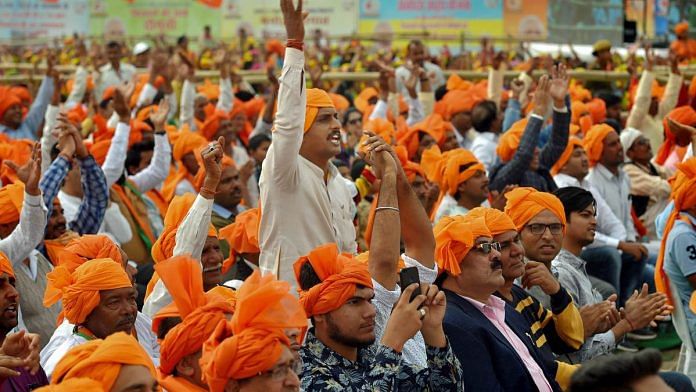The merit-loving upper caste have been given a salve by the BJP ahead of Lok Sabha elections.
This was the week when the upper caste Indian was back in the news. No, not for Hindutva, not as the torchbearer for the mighty Vedic era and definitely not as the lone spokesperson of Indian culture. Now, we have to look at the savarna Indian as a disadvantaged, marginalised and neglected citizen too. The argument isn’t new, but this time the Constitution is being prodded to come on board.
The Narendra Modi government earlier this week pushed for 10 per cent reservation in jobs and education for ‘economically backward’ upper castes.
This has been a long time coming. The upper caste Hindu has been feeling wronged for some time now – by reservation, secularism and by, of late, the government they voted to power in 2014.
And such is the power of the upper caste that in the blink of an eye, both the houses of Parliament passed the bill with an overwhelming majority. All of seven MPs in the Rajya Sabha had the courage to say no to it. The upper caste, after all, is the apple of everyone’s eye.
Also read: Modi government’s economic quota is unconstitutional
The anger
The rise of neo-Ambedkarism and the Digital Dalit – coupled with the celebration of Dalit History Month and reclaiming of spaces like Bhima Koregaon – as well as women wanting to smash Brahminical patriarchy have all added to the Savarna anxiety and caught the upper caste off guard.
So much so that the upper caste feels persecuted. They even compared themselves to the Jewish population under Hitler’s Holocaust – just because Twitter CEO Jack Dorsey loosely held a certain poster.
But this comparison isn’t new. Brahmins were compared to the Jews in an Outlook magazine article way back in 2005.
“From being the dominant community at one time, the Tamil Brahmins are facing the effects of a new casteism,” another article declared.
The growing Dalit assertion was termed ‘Brahmin bashing’. Try telling them that reverse casteism isn’t a thing.
Then social media came and mobilised mass sympathy for the upper castes, especially the Brahmins.
A near-true description of the circus happening in our country currently! pic.twitter.com/PfTsc4WQe6
— Vikram Sampath (@vikramsampath) November 21, 2018
Dear @jack maybe your team didn’t feel necessary to tell you this but the poster you are holding targets using the language of hate and violence people who constitute 5% or less of India’s 1.3 bln ppl. If that’s not hatred towards minorities, what is? Would you do this in the US? pic.twitter.com/z6OKFR82MT
— HindolSengupta (@HindolSengupta) November 19, 2018
The merit-loving upper caste Indian suddenly started feeling the need for special privileges. They felt wronged. And the Modi government was caught in an awkward position. On the one hand, OBC Narendra Modi wanted to highlight his OBC background, on the other, the upper caste was feeling neglected.
Also read: What did OBC Narendra Modi do for the OBCs?
The BJP fix
In 2014, the 56-inch chest Narendra Modi, the Hindu Hriday Samrat, was elected to power on the back of massive Hindu resentment politics. Many voted the BJP hoping Modi would give the upper caste job reservations, or do away with reservations completely.
None of that happened and the upper caste felt betrayed.
From nationwide protests against caste-based reservation to downright vandalism against the SC/ST (Prevention of Atrocities) Act, the urban, middle-class, upper-caste youth felt angry and abandoned—and left no stone unturned to say it in those many words.
The talk of private sector reservation for the SC/ST – first during the UPA rule and later when JD(U) leader Nitish Kumar raised it – made sure panic reached new heights. Who would the upper caste turn to now if even the so-called merit-islands of the private sector were ‘adulterated’?
This despite the fact that data has time and again told us that the ‘minority’ Brahmins have a disproportionately high representation in government jobs, while the SC, ST and OBCs continue to suffer on this account, despite reservation.
The Modi government then pushed back the Supreme Court’s dilution of the SC/ST Act, leading to further protests by the upper caste.
Also read: Data shows Modi-led BJP can’t bend too much to please upper caste vote base
But surely, there are better salves than offering the upper caste reservation. And then changing the poverty line from Rs 32 a day to Rs 66,000 per month for the upper caste.
Back in the 1980s, the BJP’s answer to the Mandal Commission was ‘Kamandal’, but now ironically, Modi has found a clever way of combining the two strands of modern Indian politics. We have indeed come a long way from the battle cry of Kanshiram and Mayawati in the 1980s and early 1990s: Tilak, tarazu aur talwar, inko maro joote char. Mayawati, who gave tickets to Brahmins in 2007 elections and has successively wooed the community, won’t be able to utter that slogan anymore.
“Have the savarnas ever faced untouchability, oppression, discrimination, encounters, police beatings, dropouts?” asked a livid Asaduddin Owaisi in Parliament.
These are all the things that unfortunately describe the lived experiences of Dalits, SCs, STs and Muslims even today.
But the merit-loving upper castes seem to be happy with their electoral candy, for now.




Unfortunately every word of yours filled with hatred and jealousy against us.
Muslims also wronged hindus for 1000 years then why aren’t we given reservation???